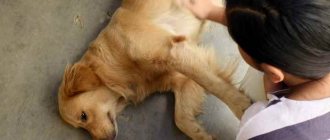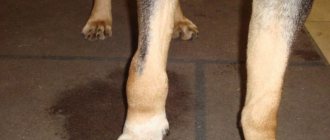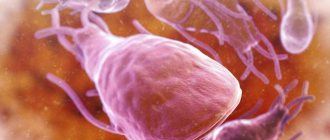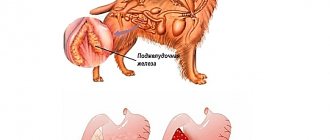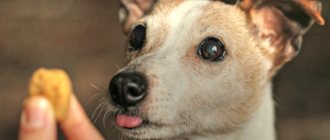Functions of the intestines in the body
The intestines in a dog’s body perform a number of functions on which not only the digestive processes depend, but also the functioning of other organs.
Small intestine
This department is responsible for:
- digestion of feed under the action of enzymes;
- absorption of feed breakdown products into the blood;
- biological disinfection of microorganisms entering the body (the intestinal walls secrete lymphoid elements);
- production of biologically active substances (serotonin, motilin and others).
Colon
This department receives leftover food that cannot be digested. The microflora of this department “eats up” what can still be absorbed. In general, in dogs, digestion processes in the large intestine are already insignificant.
Considering this section of the intestine, it should be noted that its functions are:
- absorption (of water);
- excretion (urea, uric acid).
The dog's large intestine is short. This determines physiological processes. The excretory-absorption functions take first place, and the digestive function comes second.
How is enterocolitis diagnosed in dogs?
Before prescribing treatment, the doctor must carry out a series of diagnostic measures to establish the exact cause.
and make a diagnosis.
Enterocolitis is similar in its symptoms to other diseases
, therefore, in order to avoid errors when making a diagnosis, the professionalism of a veterinarian is very important. Our veterinary office offers the services of only qualified specialists whose activities are documented.
If necessary, the specialist may prescribe additional examinations
Enterocolitis in dogs: treatment
If the diagnosis is confirmed and your pet is diagnosed with enterocolitis
, the doctor must prescribe special treatment. All efforts should be aimed at getting rid of the disease.
Prevention to prevent enterocolitis in dogs
Better than any treatment is the absence of disease. To prevent the occurrence of various intestinal pathologies
, it is necessary to practice the use of preventive measures on your pets. There are a number of recommendations that owners must adhere to when keeping animals. Here are some of them:
What diseases are considered to be gastrointestinal diseases?
Gastrointestinal diseases are diseases in which so-called inflammatory cells—cells produced in the body by wounds or injuries—invade the animal’s stomach and intestines. These include 2 groups of cells. This:
- Lymphocytes and plasmacytes are cells responsible for the body's immune responses.
- Eosinophils and neutrophils are cells responsible for cleaning damaged tissue.
With chronic inflammation, normal tissue can be replaced by fibrous (scar-like) tissue.
Chronic form of inflammation
The acute form of inflammation becomes chronic if the cause is not identified and eliminated. Even with the use of therapeutic agents, adverse factors continue to affect the intestinal mucosa. It becomes impossible to relieve the entire inflammatory reaction with medications.
Often the chronic form is observed with:
- low immunity;
- metabolic disorders;
- chronic liver diseases;
- diseases of the kidneys and cardiovascular system.
Duration of treatment for enterocolitis in dogs
Therapy for inflammation in the large and small intestines should begin as early as possible, at the first symptoms of the disease. This will avoid complications.
Diagnostic measures: blood test (biochemistry), assessment of the functioning of the liver, pancreas, liver, x-ray (foreign body), stool analysis (helminthic infestations), ultrasound, endoscopic examination.
Treatment begins with eliminating the root cause of enterocolitis and switching to a diet.
Approximate actions for enterocolitis:
- It is important to prevent dehydration, provide the animal with a sufficient amount of water, and, if necessary, give an IV (Ringer's solution, glucose, sodium chlorine).
- Relieve pain syndrome (Almagel, Imodium, etc.).
- Restore intestinal microflora (Mezim, Bifidumbacterin, Liv-52, etc.).
- Prescription of antibiotics (Penicillin, Bicilin, Etazol, etc.).
- Elimination of helminthic infestation (Piperazine, Dekaris).
- Stabilization of the immune system (Lactoglobulin, Interferon).
- Taking antiallergic drugs (Fenkarol, Suprastin).
Attention owner. Provide the dog with constant access to a bowl of clean water. Use decoctions of medicinal herbs that have astringent properties, relieve inflammation and coat the intestines. Suitable: burnet, St. John's wort, chamomile, oak bark, flaxseed, etc.
Reasons for development
Enterocolitis is usually divided into primary and secondary. The causes of the primary form of the disease are:
- Poisoning, including the entry of poisonous plants into the dog’s digestive tract (milkweed, colchicum, crocus, azalea);
- Mechanical damage to the intestines (sharp bones or foreign objects caught in it);
- The presence of harmful foods in the dog’s diet (stale, fried, containing hot spices).
The above reasons cause an inflammatory process in the intestines and the death of natural microflora, while pathogenic microorganisms receive conditions favorable for reproduction.
The secondary form of enterocolitis is a consequence of viral, bacterial, parasitic or fungal diseases: salmonellosis, giardiasis, helminthiasis, echinococcosis, parvovirus infection. The development of this type of enterocolitis can be caused by physiological pathologies of the intestine (duodenal hypertension, intestinal stenosis, the presence of a tumor), as well as dysfunction of the immune system.
Non-contagious
- The main non-infectious cause may be stress . You moved to a new place of residence, changed the dog’s place of residence, a long absence of a beloved owner, etc. all this can cause a decrease in immunity.
- Overheating or hypothermia also affects the body . The body’s resistance, its ability to resist, decreases, and at this time the virulence of microorganisms (for example, E. coli), which are in the body in a conditionally pathogenic form, increases, and all together manifests itself in clinical signs.
- Changing food can also lead to inflammation . For a certain type of food, a dog develops the production of certain enzymes. As soon as we, for example, stop introducing fermented milk products into the diet, the enzyme stops being released and after some time, the animal will react with an inflammatory reaction.
- It also happens that seemingly normal dry food that is familiar to a dog becomes the cause of inflammation . The whole point may be a low-quality batch, which for one reason or another has undergone bacterial contamination.
- With inflammation of non-contagious etiology, as a rule, the temperature does not rise . However, if help is not provided to the animal in a timely manner, the body may not cope on its own.
- The cause of inflammation may be taking antibiotics . If pneumonia was treated, and the course of treatment was delayed, antibiotics suppressed the normal functioning of the intestinal microflora, killing it, which manifested itself as inflammation. After 2–3 days, the microflora will be restored and everything will return to normal.
Stress is a non-infectious cause.
Infectious
There are a number of microorganisms (for example, salmonella) that, when entering the body of a mammal, choose the intestines as their habitat. Settling between the villous epithelium, they begin to multiply vigorously, releasing waste products into the animal’s body.
A distinctive sign of an infectious onset is an increase in temperature. It is she who says that the body is trying to fight by “burning” the pathogenic microorganism.
When an infection occurs, the dog's temperature rises.
Invasive (parasitic)
Roundworms can cause intestinal inflammation.
If the cause of intestinal inflammation is parasites, then it is not always possible to identify them by visually examining the fecal matter.
The laboratory cannot always identify the parasite. Some helminths experience a period of sexual lability, when the parasite does not release eggs into the external environment, so the laboratory will conclude that no eggs were found, but will not say that there is no parasite.
This is why it is so important to carry out timely and regular (quarterly) deworming of dogs with complex preparations..
The cause of intestinal inflammation can be roundworms living in the intestinal lumen, flat, single-celled microorganisms such as Giardia, coccidia (causing isosporosis).
Diet for enterocolitis
Once a dog has been diagnosed, it is put on a diet.
On the first day after diagnosis, the pet is not fed, but water with the addition of medicinal decoctions should be freely available. Every other day, the dog is fed raw eggs (2-3 pieces per day).
On day 3-4, start feeding your pet liquid oatmeal or rice porridge cooked in water. You can add a couple of tablespoons of boiled minced meat (beef or chicken) to it. The first portions should be small (1-2 spoons), then they are increased (if there is no reaction in the form of diarrhea or vomiting).
After 4-5 days, fermented milk products are added to the diet: kefir, cottage cheese, yogurt. You can add buckwheat and millet to rice and rolled oats. After a week, you can add boiled vegetables (carrots, zucchini, cabbage) to your pet’s menu. After 10-11 days, if there is improvement, the dog is gradually transferred to its usual diet.
Veterinarians recommend feeding an animal suffering from enterocolitis with ready-made diets. In the first week, the pet is offered pates marked Gastro Intestinal (manufacturers: Royal Canin, Hills, Purina, Farmina).
After the condition improves, you can switch the dog to the Intestinal dry diet. The duration of such a diet is 1.5-2 months, after which the pet is gradually transferred to the usual food.
Important. It is recommended to periodically feed animals with chronic enterocolitis pates or dry Gastro Intestinal diets (especially during periods of exacerbation).
Symptoms of enterocolitis
Symptoms of the disease in dogs are quite typical. The severity of the signs of enterocolitis depends on the stage and state of the body’s immune forces, as well as the factors that provoked the inflammatory process.
If the cause of the disease is a viral infection, hemorrhagic enterocolitis develops in dogs, which is characterized by nausea, vomiting and severe diarrhea with blood. Dehydration occurs a few days after the onset of symptoms. Without timely treatment, the dog dies, especially for puppies.
Symptoms of enterocolitis in dogs
In acute enterocolitis, a depressed state of the animal, a change in appetite, and the appearance of diarrhea are observed.
The stool initially has a mushy consistency, mixed with mucus, then becomes watery and contains blood.
Photo 1. Listening to a dog’s intestines using a phonendoscope to correctly diagnose enterocolitis
Severe diarrhea always occurs with tenesmus, which sometimes leads to rectal prolapse.
Palpation in the abdominal area reveals pain, and auscultation reveals increased peristaltic sounds.
With chronic enterocolitis in dogs, progressive emaciation, poor appetite, yellowness of visible mucous membranes, loss of skin elasticity, irritation and redness of the skin around the anus are noted.
Diagnosis of gastrointestinal diseases
- Upon examination, the animal looks thin; in some dogs, a thickened intestine can be felt.
- Laboratory tests usually show nothing. With very serious inflammation, damage can affect neighboring organs - the liver and pancreas.
- As a result, the body increases the content of liver enzymes and amylase, which is produced by the pancreas.
- There may be a decrease in protein levels in the blood, and with severe vomiting, there may be a decrease in the level of electrolytes, especially potassium.
In most cases, blood tests are normal, although anemia may sometimes develop. Some animals have eosinophils in their blood.
X-ray and ultrasound examinations usually do not provide any information. Sometimes thickening of the intestines and accumulation of gas may be noticeable, but this happens with many diseases.
The only way to diagnose inflammatory gastrointestinal disease is through a biopsy.
- It will show the presence of an increased number of inflammatory cells in the walls of the small intestine and the type of these cells.
- A biopsy will reveal microscopic changes in tissue that are not visible to the naked eye. In other diseases, damage to the gastrointestinal tract is quite obvious.
- When making a diagnosis, other causes of diarrhea and the appearance of infiltrates must be excluded. A stool test should rule out parasites, and the results of a blood test should rule out diseases such as hyperthyroidism, liver disease, and infection with the canine leukemia virus.
Features of the diagnosis of enterocolitis
- In order to determine the nature of your pet’s unpleasant symptoms, you should consult a veterinarian, who, in turn, must carry out a series of examinations in order to establish the correct diagnosis and prescribe adequate treatment. Initially, it is worth performing a general blood test on the animal, which should show the presence or absence of an inflammatory process in the dog’s body.
- If the animal has a disease such as gastroenterocolitis, then anemia may be observed in the blood test or all indicators may remain normal.
- If bacteria develop very rapidly in the animal’s intestines, then the dog’s body temperature may rise, and blood may also be observed in loose stools.
- If you notice that various blood clots have appeared in your pet’s stool, then you should definitely inform your veterinarian, who, using special tests, should exclude the presence of such dangerous diseases as distemper, enteritis, leptospirosis and others.
Differential diagnostic methods
Sick pets are in a severely depressed state with a weak reaction to external stimuli.
Feed consumption is reduced, and appetite is often completely absent. The change in temperature depends on the etiological factor that caused the inflammation - with toxic enteritis there is a decrease in temperature, and with others - an increase. The clinical picture is especially pronounced in acute forms of hemorrhagic, fibrinous or purulent enterocolitis:
- temperature increased by 1-2 degrees;
- severe depression, the dog constantly lies down;
- severe pain reaction, colic in dogs;
- there is no reaction to food;
- vomiting with blood, mucus, bile;
- debilitating diarrhea;
- liquid stool may contain fibrin, pus, blood - depends on the type of inflammation;
- white and gray coating on the tongue and oral mucosa;
- turgor is reduced, mucous membranes are pale, eyes are sunken, and other signs of dehydration appear.
Palpation reveals severe pain, the abdominal wall is tense. The intestinal loops are motionless, inelastic, and painful. The surface of the body is cold, this is especially pronounced at the tip of the nose, tail, paws and ears.
To clarify the diagnosis, laboratory tests are carried out - primary bacterial and viral diseases and invasive pathologies should be excluded. When examining stool, a large amount of undigested food, an increased content of fatty acids, mucus and blood are found.
Changes in the blood:
- hematocrit is increased;
- leukocytosis with a shift to the left;
- increased urea content;
- increased activity of liver enzymes.
Establishing diagnosis
Ultrasound examination of a dog's intestines.
The diagnosis cannot be made on the basis of any one sign. Only a comprehensive study, including laboratory research, can reveal the true cause and prescribe the correct treatment.
Intestinal inflammation in dogs: signs and symptoms, treatment
While keeping a dog, we take a closer look at his manners and habits, find out his taste and character, and also pay attention to his state of health.
When walking the dog, or cleaning the places where he deposits waste products, you also need to carefully consider the consistency, color, and contents. Of course, this procedure is not a pleasant one, but timely identification of something out of the ordinary will help to help the animal before it becomes irreversible.
Signs of intestinal inflammation in dogs
Very often, dog owners talk about intestinal inflammation based on a single symptom - diarrhea.
Meanwhile, constipation, bloating, pain, refusal to feed, and fever are also typical signs of inflammatory processes in the intestines.
A dog's refusal to feed is one of the signs of intestinal inflammation.
Before starting treatment, it is necessary to find out the reason, what exactly caused these or those symptoms.
Causes of inflammation
The causes of enterocolitis may be of the following nature:
- non-contagious;
- infectious;
- invasive.
Intestinal inflammation can be infectious.
Non-contagious
- The main non-infectious cause may be stress . You moved to a new place of residence, changed the dog’s place of residence, a long absence of a beloved owner, etc. all this can cause a decrease in immunity.
- Overheating or hypothermia also affects the body .
The body’s resistance, its ability to resist, decreases, and at this time the virulence of microorganisms (for example, E. coli), which are in the body in a conditionally pathogenic form, increases, and all together manifests itself in clinical signs. - Changing food can also lead to inflammation .
For a certain type of food, a dog develops the production of certain enzymes. As soon as we, for example, stop introducing fermented milk products into the diet, the enzyme stops being released and after some time, the animal will react with an inflammatory reaction. - It also happens that seemingly normal dry food that is familiar to a dog becomes the cause of inflammation . The whole point may be a low-quality batch, which for one reason or another has undergone bacterial contamination.
- With inflammation of non-contagious etiology, as a rule, the temperature does not rise .
However, if help is not provided to the animal in a timely manner, the body may not cope on its own. - The cause of inflammation may be taking antibiotics .
If pneumonia was treated, and the course of treatment was delayed, antibiotics suppressed the normal functioning of the intestinal microflora, killing it, which manifested itself as inflammation. After 2–3 days, the microflora will be restored and everything will return to normal.
Stress is a non-infectious cause.
Infectious
There are a number of microorganisms (for example, salmonella) that, when entering the body of a mammal, choose the intestines as their habitat. Settling between the villous epithelium, they begin to multiply vigorously, releasing waste products into the animal’s body.
A distinctive sign of an infectious onset is an increase in temperature. It is she who says that the body is trying to fight by “burning” the pathogenic microorganism.
When an infection occurs, the dog's temperature rises.
Invasive (parasitic)
Roundworms can cause intestinal inflammation.
If the cause of intestinal inflammation is parasites, then it is not always possible to identify them by visually examining the fecal matter.
The laboratory cannot always identify the parasite. Some helminths experience a period of sexual lability, when the parasite does not release eggs into the external environment, so the laboratory will conclude that no eggs were found, but will not say that there is no parasite.
This is why it is so important to carry out timely and regular (quarterly) deworming of dogs with complex preparations..
The cause of intestinal inflammation can be roundworms living in the intestinal lumen, flat, single-celled microorganisms such as Giardia, coccidia (causing isosporosis).
Establishing diagnosis
Ultrasound examination of a dog's intestines.
The diagnosis cannot be made on the basis of any one sign. Only a comprehensive study, including laboratory research, can reveal the true cause and prescribe the correct treatment.
A diagnosis is made based on a comprehensive study.
If it is not possible to contact a qualified specialist, and the dog needs urgent help, you must resort to the drugs available in the emergency veterinary kit.
Treatment
Let's look at various treatment regimens for intestinal inflammation in dogs.
How to treat intestinal inflammation in a dog?
Antibiotics
The first “healer” for the intestines is a group of broad-spectrum antibiotics that kill pathogenic microflora localized in the intestines.
As such a remedy, you can use the drug “ Levomycetin ”. By feeding a large (10+) dog 1/4 tablet 2 times a day, and a small dog 1/6 tablet, the result can be seen the very next day. However, this does not mean that treatment can be stopped. The course of antibiotic therapy should last at least 5–6 days.
Levomycetin fights pathogenic microflora.
Nitrofuran
Of this group of drugs, furazolidone is the most harmless and quite effective.
The drug can cope with intestinal pathogenic microflora, fungi and protozoa, which is why it is successfully used in dog breeding farms.
Furazolidone copes with protozoa in the intestinal microflora.
Dosing 3-5 mg/kg of body weight and mixing with food, the drug must be given for 7-9 days .
Anthelmintics
If the cause of inflammation is nematodes or coccidia, and the pathogenic microflora is secondary, then chloramphenicol will help for a while, and then the situation will repeat. In this case, it is necessary to use the Procox oral suspension. It will kill both roundworms and coccidia.
Procox will help get rid of roundworms.
If there is no veterinary drug at hand, you can use sulfademitoxin, which is good for isosporiasis. In this case, the dose must be maintained at 20–25 mg/kg of the dog’s weight and the drug must be administered for 10 days.
If segments of cucumber tapeworm (dipylidia) , then you cannot do without canikquantel or drontal.
conclusions
Inflammatory signs may drag on, and it will be more difficult to solve the problem on your own, so do not delay a visit to a veterinarian.
To prevent inflammation from prolonging, you need to contact a veterinarian as soon as possible.
about gastrointestinal diseases in dogs
Source: https://mykoshka.ru/lechenie-vospaleniya-kishechnika-u-sobaki/
Treatment of enterocolitis in pets
Therapy and treatment of enterocolitis largely depends on the type of disease and what caused the enterocolitis. First of all, the veterinarian must prescribe proper nutrition for the animal. In this case, the pet should always have a supply of water and direct access to a bowl of water. Fasting may be prescribed for the first 1.2 days.
After this period, it is necessary to gradually introduce the food to which the animal is accustomed. Portions should be small and gradually increased. If the dog itself indicates that it is hungry, you can give food several times throughout the day in small portions.
If you gave your dog dry food, the doctor can replace it with dietary food, which will have a better effect on the gastrointestinal tract. It is necessary to ensure that the food contains only natural meat and no protein. If you use natural products in your diet, the veterinarian will most likely give you a list of what you need, most often this is: chicken, turkey, rabbit (low-fat), low-fat cottage cheese, a decoction of cereals (rice or oatmeal), egg yolk. Vegetables are a must, can be steamed or boiled (zucchini, carrots, broccoli, cabbage).
Under no circumstances should your pet eat bones and fatty meat or fish, as well as foods that contain sugar. Dietary nutrition for enterocolitis can provoke a deficiency of certain vitamins and microelements, so the doctor should prescribe vitamin complexes, as well as various biological supplements, which will also improve the animal’s condition.
If helminths are detected, the doctor will prescribe anthelmintic therapy. To completely eliminate the disease, antibiotics (Amoxicillin, Trimethoprim) may be prescribed. In cases where a tumor is detected, removal surgery and chemotherapy may be prescribed. There are significantly fewer cases of detection and they can cause other symptoms indicating the disease.
Each drug should be prescribed individually, depending on the type and nature of the disease, as well as the possible breed characteristics of the animal. In many cases, additional painkillers are prescribed, as well as various modulators that will help avoid constipation.
Enterocolitis in dogs is a serious disease that can lead to many complications and even death. If the animal has been at home for a long time without veterinary care, then most likely doctors will only be able to eliminate the symptoms, and the disease will become chronic.
Approximate treatment plan
We emphasize that the treatment regimen we have given is very approximate, since in each specific case the cause of inflammation is different, and therefore the therapy itself will vary. But still, general principles of treatment can be identified:
- In many cases, diarrhea is treated first. For this, astringents are prescribed.
- In order to eliminate dehydration and relieve severe intoxication, the animal is given as much clean and fresh water as possible. If a pet cannot drink on its own due to weakness and general apathy, buffer compounds are administered intravenously.
- Depending on the root cause of the inflammation, the dog is prescribed antibiotics or other antimicrobial drugs, anthelmintic or other antiparasitic agents.
- If the animal is poisoned, an appropriate antidote is prescribed (if available).
- In severe cases, plasma transfusion is recommended (this will quickly relieve dehydration and restore normal ESR).
Digestive Enzyme Treatment
- When a dog has intestinal inflammation, the symptoms and treatment are always very similar. The best treatment is digestive enzymes, such as Prozyme. They make the pancreas work more efficiently and normalize the animal’s intestines. We bring to your attention an effective recipe.
- “A dog weighing up to 15 kg should be given 1/4 teaspoon of Prozym morning and evening. Dogs that weigh between 15 and 30 kg should take 1/2 teaspoon morning and evening. Larger dogs should be given 1 teaspoon, also in the morning and evening.”
- You can buy Prozym in veterinary pharmacies, as well as in pet stores. It must be given to the animal along with food. It is worth noting that when a dog has inflammation of the large intestine, the symptoms differ, but the method of treatment remains the same. Enzymes will help with diseases of both the large and small intestines.
Colitis in dogs - treatment at home
In today's busy life, this is very useful, as it saves your time and nerve cells. At home, you can provide full veterinary care “YA-VET” in compliance with sterility and antiseptic conditions, with all the necessary equipment and medications. Needless to say, houses and walls help; a sick pet will be calmer and recover faster in a familiar environment. For complex patients, there is a hospital, as sometimes the animal requires careful monitoring and intensive care. Call us and we will help keep your beloved dog healthy!
Once a dog has been diagnosed, it is put on a diet.
On the first day after diagnosis, the pet is not fed, but water with the addition of medicinal decoctions should be freely available. Every other day, the dog is fed raw eggs (2-3 pieces per day).
On day 3-4, start feeding your pet liquid oatmeal or rice porridge cooked in water. You can add a couple of tablespoons of boiled minced meat (beef or chicken) to it. The first portions should be small (1-2 spoons), then they are increased (if there is no reaction in the form of diarrhea or vomiting).
After 4-5 days, fermented milk products are added to the diet: kefir, cottage cheese, yogurt. You can add buckwheat and millet to rice and rolled oats. After a week, you can add boiled vegetables (carrots, zucchini, cabbage) to your pet’s menu. After 10-11 days, if there is improvement, the dog is gradually transferred to its usual diet.
Veterinarians recommend feeding an animal suffering from enterocolitis with ready-made diets. In the first week, the pet is offered pates marked Gastro Intestinal (manufacturers: Royal Canin, Hills, Purina, Farmina).
Symptoms
One of the main signs of enterocolitis in dogs is diarrhea. At the beginning of the disease, the feces are mushy with mucus, then they become watery, often mixed with blood. With prolonged diarrhea, tenesmus (false bowel movements) may appear; eventually, diarrhea can lead to weakening of the rectal ligaments and its prolapse. Possible alternation of diarrhea and constipation. Due to frequent licking of the anal area, it can become inflamed.
Usually there is rumbling and bloating.
With chronic enterocolitis, the animal experiences weight loss, metabolic disorders, and a lack of vitamins and microelements.
Prevention
Measures to prevent the development of enterocolitis in a dog include:
- Timely vaccination and treatment against parasites;
- Using fresh and high-quality feed, and for old and weakened animals, following a light diet;
- Walking the dog on a leash, eliminating the possibility of eating garbage;
- Limit the dog's contact with other animals.
Any digestive disorder in a dog should prompt a visit to the veterinarian, since a disease in the initial phase of development can often be cured within a few days, while a disease that has become chronic often requires many years of treatment and may have a poor prognosis.
Treatment of enterocolitis in dogs at home
Therapy primarily depends on the type of causative agent of the disease. In most cases, the veterinarian will prescribe a special diet for a sick dog. A therapeutic fast may be recommended for a day or two, only drinking is allowed. The pet should receive a sufficient amount of drinking water - this will prevent dehydration.
If the animal has previously been fed, the doctor may recommend special food for dogs with gastrointestinal problems. If the pet is accustomed to natural products, the veterinarian will provide a list of allowed products.
During rehabilitation the following are allowed:
- Lean meat, chicken, turkey.
- Cottage cheese with minimal fat content.
- Decoctions of cereals, oatmeal or rice are suitable.
- Egg yolks.
During rehabilitation the following are prohibited:
- Egg white.
- Products with high sugar content.
- Bones.
- Fatty meat and fish.
Why does enterocolitis occur in dogs?
Colitis is an inflammation or infection limited to the colon. Enteritis is inflammation of the small intestine. Together, both inflammatory processes are a disease called enterocolitis. The course of the disease varies: from mild to acute, severe and even fatal. There is also a chronic form, which persists for a long time, causing a general deterioration in the dog’s health.
There is a wide list of reasons that cause inflammation in the intestines. Among them:
- eating garbage and junk food (fatty and spicy, very cold or too hot);
- ingestion of toxins, irritants or foreign objects;
- sudden change in diet;
- bacterial, viral and parasitic infections;
- allergies;
- disruption of intestinal function;
- cancer;
- diseases of the immune system.
Did you know? The digestion time of food in a dog's intestines is longer than that of a human. It can exceed 12 hours and depends on the calorie content of the food eaten.
Infections
Infections often irritate the lining of your pet's colon. They get inside with food or due to poor hygiene. This is accompanied by vomiting, diarrhea and other symptoms.
Infectious enterocolitis can be caused by:
- bacterial;
- viral;
- fungal infections.
Among the most common bacteria are salmonella, E. coli, Staphylococcus aureus, Shigella, and Yersinia. The infectious form of the disease is dangerous for humans, as people can become infected by coming into contact with a sick animal. Therefore, you must always follow the rules of hygiene.
Symptoms of enterocolitis may also appear after treatment with antibiotics. During such treatment, part of the microflora dies, which creates an ideal environment in the intestines for infection by more harmful bacteria. As they spread, they release toxins and damage the walls of the gastrointestinal tract.
Symptoms of infectious enterocolitis:
- convulsions;
- bloating;
- frequent bowel movements;
- watery diarrhea;
- severe abdominal pain.
Did you know? Infections cause 80% of enterocolitis.
Parasite infestation
Intestinal parasites in dogs are:
- round and tapeworms;
- The simplest unicellular organisms are Giardia.
Various pathogens take up residence in your pet's digestive tract, and they are far from beneficial. But the problem is that most of them cannot be detected visually. Therefore, periodic examination of the dog and regular deworming will be very necessary.
Tumors
Changes in the intestinal wall caused by a tumor can also cause inflammation. The diagnosed neoplasm can be benign or malignant. Treatment will depend on what diagnosis the doctor determines.
Other reasons
Toxic or unhealthy foods for the intestines (fatty, spicy, hot, cold) can provoke an inflammatory process. Plus, most dogs don't mind looking in the trash can or digging up something tempting in the yard. The thing is that they have several times fewer taste buds than humans. Therefore, much that attracts their attention is unacceptable to the stomach, but the dog will find it to taste quite good.
Important! When playing with your dog, avoid muddy or wet areas. Bacteria, fungi, viruses and parasites are found precisely in places where there is moisture, soil and debris.
Intestinal trauma can also cause intestinal irritation. You can be injured by a bone or an object swallowed during play. Some foods cause an allergic reaction in the intestines. Food allergies cause itching of the skin, paws and ears. Fortunately, enterocolitis caused by food is much easier to treat. To do this, simply remove the irritating product from your diet.


